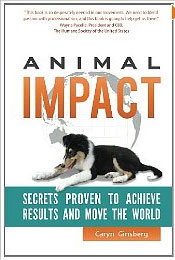 I first stumbled into awareness of animal advocacy consultant Caryn Ginsberg’s Animal Impact: Secrets Proven to Achieve Results and Move the World (Priority Ventures Group, Arlington, VA, 2011) on the web site of the Humane Research Council, a treasure trove of animal welfare-related research, statistics, and trend analyses. Within seconds of reading the synopsis, I deemed it a must-read. Not only did the book strike me as directly relevant given my line of work, but its roster of interviewees and endorsers constituted a veritable Who’s Who of heavy hitters from all across the animal welfare field; represented organizations ranged from the ASPCA, the Humane Society of the United States, and PetSmart Charities International to Mercy for Animals and Compassion Over Killing to Spay/USA to the Vegetarian Resource Group, Wildlife SOS, the World Society for the Protection of Animals, and the Humane Research Council itself…to name just a few.
I first stumbled into awareness of animal advocacy consultant Caryn Ginsberg’s Animal Impact: Secrets Proven to Achieve Results and Move the World (Priority Ventures Group, Arlington, VA, 2011) on the web site of the Humane Research Council, a treasure trove of animal welfare-related research, statistics, and trend analyses. Within seconds of reading the synopsis, I deemed it a must-read. Not only did the book strike me as directly relevant given my line of work, but its roster of interviewees and endorsers constituted a veritable Who’s Who of heavy hitters from all across the animal welfare field; represented organizations ranged from the ASPCA, the Humane Society of the United States, and PetSmart Charities International to Mercy for Animals and Compassion Over Killing to Spay/USA to the Vegetarian Resource Group, Wildlife SOS, the World Society for the Protection of Animals, and the Humane Research Council itself…to name just a few.
While the book is a worthwhile read for all who are committed to making the world a better place for animals, it is most useful for those on the front lines of advocacy campaigns, communications, and marketing at animal-focused organizations — Ginsberg argues that effective messaging is the cornerstone of organizational success. Her narrative deftly interweaves best-practice tips, real-life case studies, words of wisdom from over 80 animal welfare and animal rights leaders (gleaned from both successful and failed efforts), thoroughly researched statistics, and thought-provoking exercises. All these are presented through the lens of Ginsberg’s signature ACHIEVEchange™ system built on the following tenets:
Action [Should Be Tailored to] Audience
Create Benefits & Cut Barriers
How to Say Something to Someone Instead of Nothing to Everyone
I Am Not My Target Audience
Education Isn’t Enough
Voice Matters
Evaluate, Don’t Guess
A recurring theme throughout the book is a strong emphasis on the importance of people skills to successfully and sustainably change hearts, minds, and deeply ingrained cultural norms and individual habits. This entails meeting people where they are — allowing them to lean into change gradually and draw upon what uniquely drives them — and consistently demonstrating outstanding customer service and high levels of accountability, transparency, and integrity. In short, Ginsberg’s book strives to professionalize what is in many respects still a grassroots movement led by people whose perspective, experiences, and personal motivations tend to be markedly different from those of their target audiences — with the understanding that for many of these leaders, some of their toughest customers may be their own friends and family. The book also underscores the necessity of thoughtful, strategic marketing for maximum effectiveness and impact.
Admirably, Ginsberg refrains from promoting any specific political agenda and presents ideas from leaders whose positions span the gamut along the animal welfare/animal rights spectrum, neither condoning nor condemning any of these positions. Instead, she highlights common threads that illustrate concrete principles for strengthening the success of advocacy efforts.
I had hoped that the book would contain more substantive information about conducting outcome evaluations to assess organizational impact, but this topic was limited to only one chapter that merely scratched its surface. On the other hand, an unexpected boon was the footnotes section referencing the wealth of sources from which the author drew her vast array of relevant statistics scattered throughout — I actually found this one of the most helpful components of the entire book. Thanks to Ginsberg’s well-documented research, I now know which sources to consult in the future for U.S. statistical information such as:
- Total lab animal population
- Total number of healthy/adoptable dogs and cats euthanized in shelters annually
- Total number of animals killed for food and hunted for sport annually
- Annual dollar value of animals sold by pet stores and breeders
- Annual dollar value of fur sales
- Percentage of U.S. adults who follow animal-related news stories daily, weekly, or monthly
- Proportion of universities with human-animal studies courses or animal law programs, and proportion of medical schools that do not require terminal animal labs
- Annual per capita consumption of animal products
- Proportion of states with felony-level animal cruely laws
The book also introduced me to The Social Animal, an online resource geared toward helping animal advocates make the best use of social media. Additionally, the book includes a link to a free downloadable digital companion workbook pre-populated with key points and exercises from each chapter and the functionality to insert one’s own notes as desired, which I found especially helpful.
At one time or another, all of us in the animal welfare field — regardless of our role or level of expertise — are called upon to advocate for our cause. From that perspective, Animal Impact is the ideal tool to help ensure that when that time comes, our words and actions truly advance the best interests of the animals we work so passionately to protect.
Filed under: Uncategorized | 1 Comment »


 I first stumbled into awareness of animal advocacy consultant Caryn Ginsberg’s
I first stumbled into awareness of animal advocacy consultant Caryn Ginsberg’s